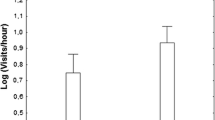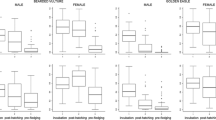Abstract
According to parental investment theory, nest defence activity should be related to the reproductive value of the offspring. Alternative hypotheses suggest that defence activity may, for example, depend upon the conspicuousness of the young. Studies concerning this topic have been carried out almost exclusively on birds and experimental data on the diversity of organisms is lacking. Bank voles Clethrionomys glareolus were used to study the effects of the number and age of offspring upon the pup defence activity of mothers. Male bank voles are infanticidal and thus an adult male was used as a predator. Defence trials were conducted in the laboratory and filmed for subsequent analysis. Litter sizes were divided into three treatment groups: reduced (−2 pups), control (±0 pups) and enlarged (+2 pups). In order to study the effect of offspring age upon maternal defence activity the trials were conducted twice: when the pups were 3 and 8 days old. Defence activity increased with the number of offspring and enlarged litters were most actively defended. This result supports parental investment theory and conclusions drawn by earlier studies of birds. However, in contrast to the conclusions of earlier studies, older offspring were defended less than the younger ones. Whilst new-born pups are totally defenceless against predators their vulnerability decreases as they age. Therefore, we suggest that maternal aggression in female bank voles is related to the value as well as to the vulnerability of the offspring. The validity of this explanation and the determinants of parental investment decisions in small mammals in general deserve further study.
Similar content being viewed by others
References
Barash, D.B. (1975) Evolutionary aspects of parental behavior: distraction behavior of the alpine accentor. Wils. Bull. 87, 367–373.
Bronson, F.H. (1989) Mammalian Reproductive Biology. University of Chicago Press, Chicago.
Carlisle, T.R. (1985) Parental response to brood size in a cichlid fish. Anim. Behav. 33, 234–238.
Curio, E. and Regelmann, K. (1986) Do great tit Parus major parents gear their brood defence to the quality of their young? Ibis 129, 344–352.
Dale, S., Gustavsen, R. and Slagsvold, T. (1996) Risk taking during parental care: a test of three hypotheses applied to the pied flycatcher. Behav. Ecol. Sociobiol. 39, 31–42.
Gandelman, R. and Simon, N.G. (1980) Postpartum fighting in the rat: nipple development and the presence of young. Behav. Neur. Biol. 28, 350–360.
Gustafsson, L. and Sutherland, W.J. (1988) The costs of reproduction in the collared flycatcher Ficedula albicollis. Nature 335, 813–815.
Harvey, P.H. and Greenwood, P.J. (1978) Anti–predator defense strategies: some evolutionary problems. In J.R. Krebs and N.B. Davies (eds.) Behavioral Ecology: An Evolutionary Approach, Blackwell, Oxford, pp. 129–151.
Hausfater, G. and Hrdy, S.B. (1984) Infanticide–Comparative and Evolutionary Perspectives. Aldine, New York.
Hrdy, S.B. (1979) Infanticide among mammals: a review, classification and examination of the implication for the reproductive strategies of females. Ethol. Sociobiol. 1, 13–40.
Knight, R.L. and Temple, S.A. (1986a) Nest defence in the American goldfinch. Anim. Behav. 34, 887–897.
Knight, R.L. and Temple, S.A. (1986b) Why does intensity of avian nest defence increase during the nesting cycle? Auk 103, 318–327.
Koskela, E., Mappes, T. and Ylönen, H. (1997) Territorial behavior and reproductive success of bank vole Clethrionomys glareolus females. J. Anim. Ecol. 66, 341–349.
Koskela, E., Mappes, T. and Ylönen, H. (1999) Experimental manipulation of breeding density and litter size: effects on reproductive success in the bank vole. J. Anim. Ecol. 68, 513–521.
Koskela, E., Jonsson, P., Hartikainen, T. and Mappes, T. (1998) Food limitation on reproductive success: an experiment in bank vole Clethrionomys glareolus. Proc. R. Soc. B. 265, 1129–1134.
Labov, J.B., Huck, U.W., Elwood, R.W. and Brooks, R.J. (1985) Current problems in the study of infanticidal behavior of rodents. Quart. Rev. Biol. 60, 1–20.
Lavery, R.J. and Keenleyside, M.H.A. (1990) Parental investment of a biparental cichlid fish, Cichlasoma nigrofasciatum, in relation to brood size and past investment. Anim. Behav. 40, 1128–1137.
Lazarus, J. and Inglis, I.R. (1986) Shared and unshared parental investment, parent–offspring conflict and brood size. Anim. Behav. 34, 1971–1804.
Listøen, C., Karlsten, R.F. and Slagsvold, T. (2000) Risk taking during parental care: a test of the harm–to–offspring hypothesis. Behav. Ecol. 11, 40–43.
Maestripieri, D. (1992) Functional aspects of maternal aggression in mammals. Can. J. Zool. 70, 1069–1177.
Maestripieri, D. and Alleva, E. (1990) Maternal aggression and litter size in the female house mice. Ethology 84, 27–34.
Mallory, F.F. and Brooks, R.J. (1980) Infanticide and pregnancy failure: reproductive strategies in the female collared lemming (Dicrostonyx groenlandicus). Biol. Reprod. 22, 192–196.
Mappes, T., Koskela, E. and Ylönen, H. (1995) Reproductive costs and litter size in the bank vole. Proc. R. Soc. B. 261, 19–24.
Montgomerie, R.D. and Weatherhead, P.J. (1988) Risks and rewards of nest defence by parent birds. Quart. Rev. Biol. 63, 167–187.
Morris, D.W. (1985) Natural selection for reproductive optima. Oikos 45, 290–292.
Norrdahl, K. and Korpimäki, E. (1995) Mortality factors in a cyclic vole population. Proc. R. Soc. B. 261, 49–53.
Nur, N. (1983) On parental investment during the breeding season. Anim. Behav. 31, 309–311.
Onnebrink, H. and Curio, E. (1991) Brood defence and the age of young: a test of the vulnerability hypothesis. Behav. Ecol. Sociobiol. 29, 61–68.
Perrins, C.M. (1965) Population fluctuations and clutch size in the great tit Parus major L. J. Anim. Ecol. 34, 601–647.
Perrins, C.M. and Moss, D. (1975) Reproductive rates in the great tit. J. Anim. Ecol. 44, 695–706.
Pressley, P.H. (1981) Parental effort and the evolution of nest–guarding tactics in the threespine stickleback, Gasterosteus aculaetus L. Evolution 35, 282–295.
Redondo, T. (1989) Avian nest defence: theoretical models and evidence. Behaviour 111, 161–195.
Rytkönen, S., Koivula, K. and Orell, M. (1990) Temporal increase in nest defence intensity of the willow tit (Parus montanus): parental investment or methodological artifact? Behav. Ecol. Sociobiol. 27, 283–286.
Rytkönen, S., Orell, M. and Koivula, K. (1995) Pseudo Concorde fallacy in the willow tit? Anim. Behav. 49, 1017–1028.
St. John, R.D. and Corning, P.A. (1973) Maternal aggression in mice. Behav. Biol. 9, 635–639.
Svare, B. and Gandelman, R. (1976) Suckling simulation induces aggression in virgin female mice. Nature 260, 606–608.
Tapper, S. (1979) The effects of fluctuating vole numbers (Microtus agrestis) on a population of weasels (Mustela nivalis) on farmland. J. Anim. Ecol. 48, 603–617.
Trivers, R.L. (1972) Parental investment and sexual selection. In B. Cambell (ed) Sexual Selection and the Descent of Man, Aldine, Chicago, pp. 136–179.
Wiklund, C.G. (1990) Offspring protection by merlin Falco columbarius females; the importance of brood size and expected offspring survival for defence of young. Behav. Ecol. Sociobiol. 26, 217–223.
Wilson, W.L., Elwood, R.W. and Montgomery, W.I. (1993) Infanticide and maternal defence in the wood mouse Apodemus sylvaticus. Ethol. Ecol. Evol. 5, 365–370.
Winkler, D.W. (1987) A general model of parental care. Am. Nat. 130, 526–543.
Winkler, D.W. (1991) Parental investment decision rules in tree swallows: parental defence, abandonment, and so called Concorde Fallacy. Behav. Ecol. 2, 133–142.
Wolff, J.O. (1985) Maternal aggression as a deterrent to infanticide in Peromyscus leucopus and Peromyscus maniculatus. Anim. Behav. 33, 117–123.
Wolff, J.O. (1993) Why are small mammals territorial? Oikos 68, 364–370.
Wolff, J.O. and Peterson, J.A. (1998) An offspring–defence hypothesis for territoriality in female mammals. Ethol. Ecol. Evol. 10, 227–239.
Author information
Authors and Affiliations
Rights and permissions
About this article
Cite this article
Koskela, E., Juutistenaho, P., Mappes, T. et al. Offspring Defence in Relation to Litter Size and Age: Experiment in the Bank vole Clethrionomys glareolus. Evolutionary Ecology 14, 99–109 (2000). https://doi.org/10.1023/A:1011051426666
Issue Date:
DOI: https://doi.org/10.1023/A:1011051426666




